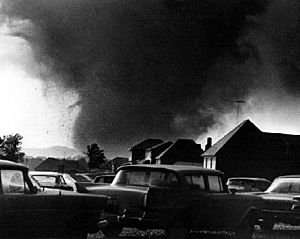Tornado outbreak sequence of June 1966 facts for kids

A photograph of the F5 Topeka, Kansas tornado.
|
|
| Type | Tornado outbreak |
|---|---|
| Duration | June 3–12 |
| Tornadoes confirmed | 57 |
| Max rating1 | F5 tornado |
| Duration of tornado outbreak2 | ~11 days |
| Damage | $104 million (1966 USD) |
| Total fatalities | 18 fatalities, 543 injuries |
| Areas affected | Southern and Midwestern United States, Great Plains |
| 1Most severe tornado damage; see Fujita scale 2Time from first tornado to last tornado | |
The Tornado outbreak sequence of June 1966 was a series of powerful tornado outbreaks that hit parts of the Southern and Midwestern United States and the Great Plains. These storms happened over about 11 days, from June 2 to June 12, 1966. During this time, 57 tornadoes were confirmed. Sadly, 18 people lost their lives, and 543 others were injured.
The most damaging tornado of this sequence struck on the evening of Wednesday, June 8, 1966. This was when a very strong F5 tornado hit Topeka, Kansas. It started in the southwest part of the city and moved northeast, tearing through several neighborhoods and even passing over a local landmark called Burnett's Mound.
Contents
The Topeka, Kansas Tornado
A Local Legend and the Tornado
A local Native American legend in Topeka said that Burnett's Mound, a hill named after a Potawatomi Indian chief, would protect the city from tornadoes. People believed the hill, which is about 250 feet (76 meters) tall, would make any tornado heading for Topeka disappear.
However, a few years before 1966, a water tower was built on the mound. This made many Topeka residents worried. They thought it might weaken the mound's special protection against tornadoes. Even before this tornado, ten other tornadoes had hit Topeka since Kansas started keeping tornado records in 1889. But the 1966 tornado was much stronger than any of the previous ones.
How the Tornado Formed
The Topeka tornado began to form at 6:55 p.m. Central Time on June 8. It first touched down about 8 miles (13 kilometers) west of the city. At that time, the National Weather Service had trouble seeing the tornado on their radar. This was because the Topeka office used an older military radar system. It was given to the U.S. government after World War II. While this radar was considered good for its time, it wasn't as good at finding tornadoes as the Doppler weather radar we have today.
Around 7:30 p.m., a very wide tornado, about 1/4 to 1/2-mile (400–800 meters) across, moved into the southwest side of Topeka. It continued moving northeast, passing right over Burnett's Mound.
A Reporter's Warning
Bill Kurtis, who was a reporter for WIBW-TV (channel 13) at the time, saw the devastating storm approaching. He wanted to warn people to find shelter immediately. In a calm but very serious voice, he urged viewers, "for God's sake, take cover!" Many people believe his urgent message saved many lives.
Damage and Impact
The tornado caused a huge amount of damage. The total cost was estimated at $104 million in 1966. This would be about $970 million today, making it one of the most expensive tornadoes in U.S. history.
Sixteen people were killed, and many others were injured. Experts believe that if the tornado had hit during school or work hours, or in the middle of the night, as many as 5,000 people could have died. Bill Kurtis is widely credited with saving many lives because of his quick and urgent warning to the public.
Images for kids



